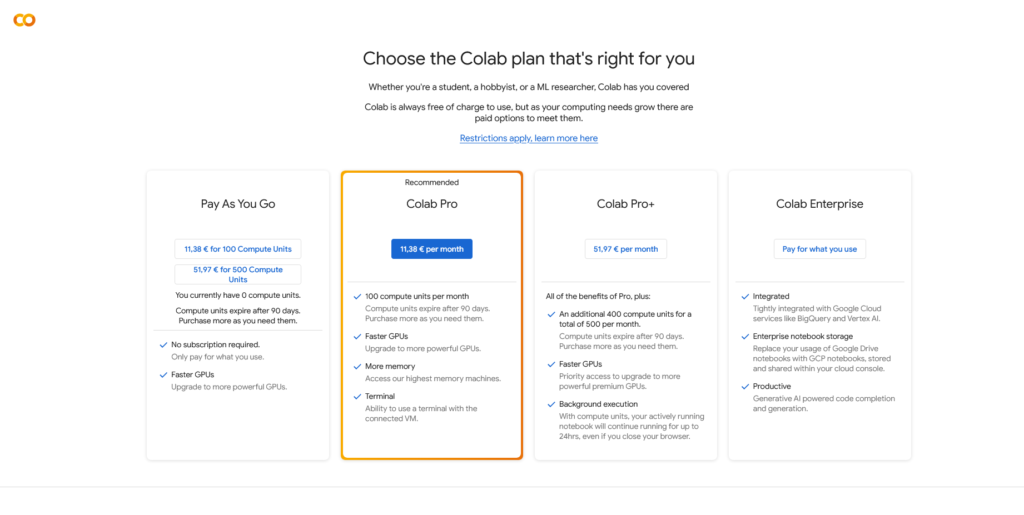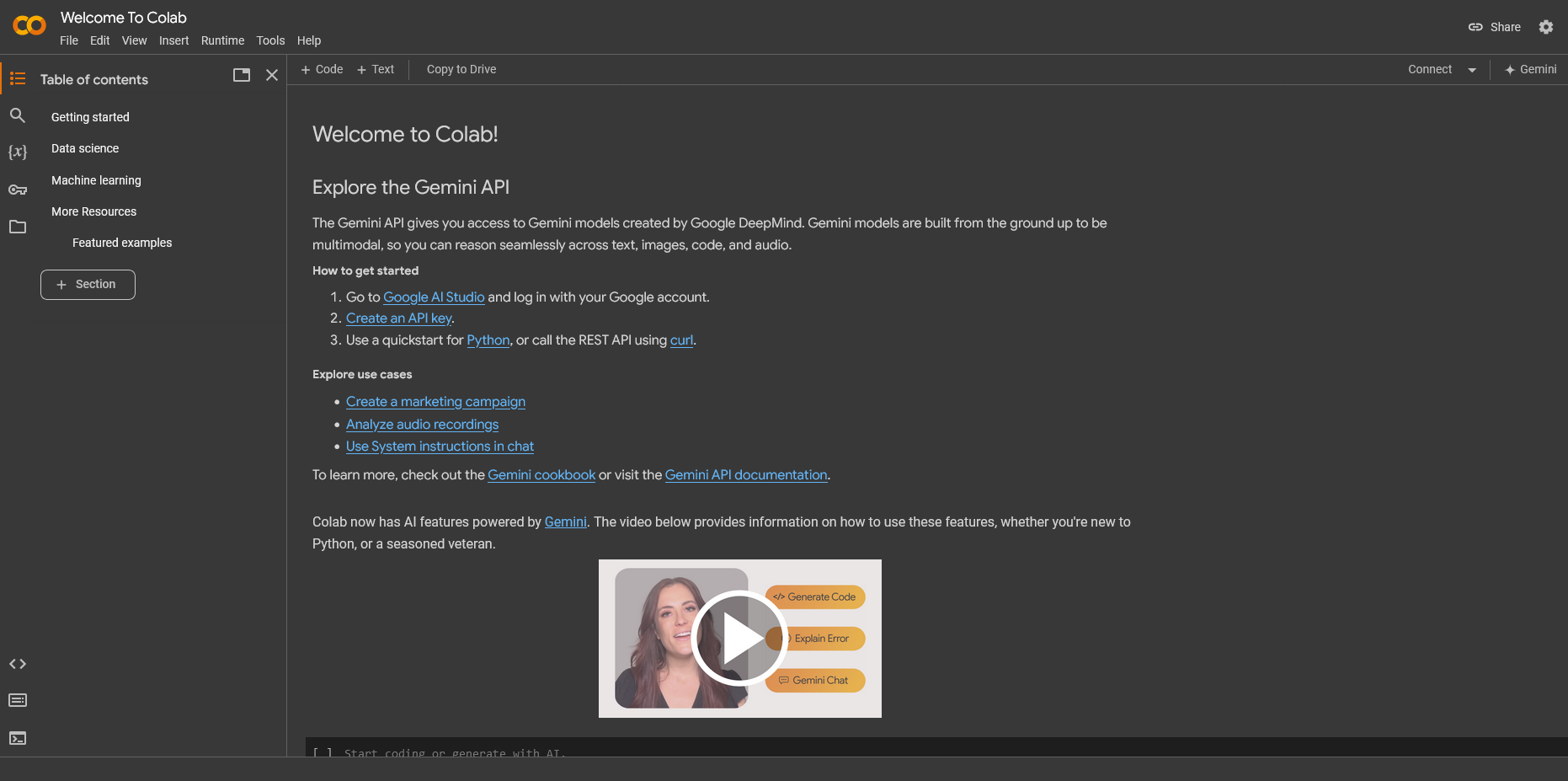Every day, many people dive into Python programming, aiming for innovation and tech breakthroughs. Cloud computing is now a key tool for their creativity. It’s perfect for data science pros, machine learning fans, or AI researchers who want to bring their ideas to life easily. Google Colab, or “Colaboratory,” is here to help with its free, cloud-based Jupyter notebooks. It’s a place where dreamers and doers come together, powered by code.
Imagine a world where setting up is a breeze, and your only hurdle is your next big idea. Google Colab offers a smooth experience for Python programming. It feels like working in a university or a cutting-edge tech center. With just an internet connection and a browser, you can dive into a world where sharing Python notebooks, accessing strong computing power, and connecting with others is easy. Google Colab is proof that the future of data science, machine learning, and AI research is open, collaborative, and powerful.
Key Takeaways
- Google Colab makes Python programming easy with no setup needed.
- It’s fully cloud-based, letting you access Jupyter notebooks from any browser.
- It’s great for data science and machine learning, offering strong computing on the go.
- Supports AI research with features for sharing and collaborating on analyses.
- Provides free access to GPUs and TPUs, making high-performance computing available to all.
Exploring Google Colab: A Comprehensive Overview
Google Colab is a key player in cloud-based machine learning and a great educational tool. It’s a browser-based platform that lets users explore interactive coding environments. These are perfect for data analysis, Python development, and collaborative programming. Let’s dive into what Google Colab is, its benefits for Python development, and how it fits with Google’s tools.
What is Google Colab?
Google Colab is a web service that lets you write and run Python code in your browser. It’s made for machine learning and data science projects. This platform is free, needs no setup, and is great for students and professionals.
The Benefits of Using Google Colab for Python Development
Google Colab makes Python programming easier. It comes with many libraries already installed, so you can start coding right away. You can also work together with others on projects and keep your work in sync using Google Drive.
Google Colab’s Integration with Google Drive and Google Suite
Google Colab works well with Google Drive and Google Suite, making it great for teamwork. You can easily save and share your work with others. Plus, you can use the cloud for data analysis and machine learning projects.
| Feature | Benefits |
|---|---|
| Cloud-Based Platform | Accessible from any device, facilitates collaborative programming |
| Integration with Google Drive | Simplifies file storage and sharing |
| Pre-installed Libraries | Enables immediate start with projects, ideal for educational purposes |
| Free Access to Computing Resources | Provides essential support for data analysis and cloud-based machine learning projects |

Click here to visit website
Getting Started with Google Colab
Starting with Python can seem tough, but Google Colab makes it easier for both new and intermediate users. It’s a great place to work on projects, share them, and keep track of your work. Let’s explore how you can use Colab notebooks for Python tutorials, code execution, and project collaboration.
First, setting up a Google Colab account is easy. Just log in with your Google account and find Colab through Google Drive or the Colab website. This makes working together on projects simple, without the need to switch between different tools.
After logging in, creating a new Colab notebook is easy. Go to the ‘File’ menu and choose ‘New Notebook’ to start coding. Here’s what you’ll see first:
Google Colab is great for running code execution. Just type your Python code into the cells. For example, to print a message, you can use:
Hit the play button or press Ctrl+Enter to run it. You’ll get quick feedback, which is great for learning and fixing your code. This makes it a top choice for Python tutorials.
Project Collaboration and Best Practices
For project collaboration, sharing your notebook is as simple as sending any file on Google Drive. Just add collaborators by their email, and they can see or edit the notebook based on your settings.
- Save Frequently: Don’t lose your work by saving automatically or doing it yourself often.
- Document Your Code: Use comments and text cells to explain your code to others.
- Organize Your Work: Use sections and cells to keep your code tidy and logical.
By following these tips, Colab notebooks make learning and managing projects easier. They also boost team efficiency and collaboration. Explore Google Colab’s many features and improve your coding skills in a supportive environment.
Advanced Features and AI Tools in Google Colab
Google Colab is leading the way in AI by offering tools that speed up AI models and deep learning. It uses TensorFlow and PyTorch, making AI easier for everyone. This shows Google’s effort to make AI accessible to more people by giving them the tools they need.
Utilizing Google Colab for Machine Learning Projects
Google Colab makes coding AI models easy by working well with TensorFlow and PyTorch. This lets developers and scientists use deep learning without requiring a lot of hardware. It’s great for both beginners and experts, making it easier to work on and share projects.
Collaborative Features and Real-Time Sharing in Colab
Google Colab lets teams work together in real time, no matter where they are. It supports live editing and commenting, perfect for school or work projects. This way, teams can improve AI models together easily and clearly.
Access to Free GPUs and TPUs for Intensive Computations
Google Colab gives users free GPUs and TPUs for complex AI tasks. This speeds up the process and saves money for those needing lots of computing power. Using these tools can cut down the time it takes to train and improve AI models.

| Feature | Description | Benefits |
|---|---|---|
| TensorFlow Integration | Direct support within Colab notebooks | Enables building and training machine learning models efficiently |
| PyTorch Support | Compatible for seamless implementation | Facilitates robust deep learning model development |
| Real-Time Collaboration | Co-editing and dynamic sharing capabilities | Enhances productivity and accelerates project development |
| Access to GPUs/TPUs | Free accelerated hardware resources | Reduces training time for computationally intensive tasks |
If you haven’t read our post about Artificial Intelligence, kindly click here to learn more about AI.
Conclusion
Looking back, Google Colab has changed the game in innovations in cloud computing. It’s a key tool for Python programming and working together on data analysis. Thanks to community-driven development, it shows how sharing knowledge and resources can change the game in data science. With regular Colab updates, it keeps bringing new tools and ideas to the table for everyone to use.
The future of data science is closely tied to tools like Google Colab. It makes complex tasks easier, helps people work together smoothly, and gives users access to the latest tech like free GPUs and TPUs. This makes machine learning and AI more accessible to people all over the world. It boosts productivity and encourages new ways to solve real-world problems with data.
Looking forward, Google Colab will keep playing a big role in teaching and growing skills in AI and machine learning. In a world where data is everything, having the right tools to work with it is key. Google Colab is more than a platform; it’s a spark for discovery. It helps us use data science to its fullest, leading us into a future of knowledge, teamwork, and endless innovation.



